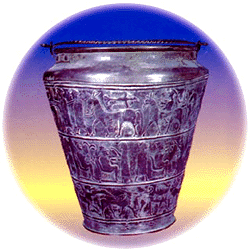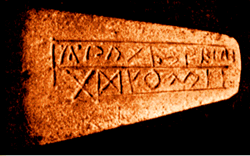The
Origin of Slovenians: Veneti
|
|
Veneti
- Early Ancestors of Slovenians
It has long been the official and
established view of historians that Slovenes migrated to the lands
in the heart of Europe, which they still occupy today, as part
of the great west- and southwards movement by the Slavs during
the 6th century. The arrival of these tribes on the borders of
the Byzantine empire was dramatic and well recorded by the historians
of the day. The arrival of Slovenes, the Slavic people who had
settled furthest west, reaching as far as the hinterland of Venice
was not recorded at all.
The most recent and compelling hypothesis,
which makes an impressive attempt to explain the origins of Slovenian
people, is the combined effort and complementary research by three
authors, Jozko Savli, Matej Bor and Ivan Tomazic. The book was
published in the eighties in Slovenian, English and German translations,
with the English title Veneti. First Builders of European Community.
The work is distinguished by the
freshness and the originality of approach, freedom from political
bias and preconceived ideas, the linguistic and topographical
data collected, persuasive arguments, and the highlighting of
the Venetic origin theory by the use of contemporary historical
sources.
|

|
| |
The
Situla: An example of the Hallstatt culture or the symbol of Venetic
culture?
The art of situla-making reached the highest point of development
in the 6th century B.C. The majority of situlas and other articles
decorated in that distinct style have been found on territory of
the present-day Slovenia
|
LOOMSONG
A song at the Loom
Very interesting and entertaining is
the inscription on a clay loom weight. Venetologists do not know
where to begin, and yet on the basis of the Ateste grammar tablets,
it is totally understandable.
On this weight made of clay there are two beautiful verses:
O PATE SPESS TI TAKOAUJI
LOV(E) KLOKATU, APAJA VOLTIOM
In Slovenian:
Sede ob petljeh spess ti tkaje,
Klekelj love, viteze opevajocc.
In English:
Between the warps with speedy bobbins,
You weave, and sing your songs of knights. |
 |
Jozko Savli maintains that the West Slavs are indigenous to Central
Europe and that it was the Slavic Veneti or Wends who were the first
disseminators of a major cultural complex in central Europe - the
Urnfeld culture. He postulates that in a migration originating circa
1200 BC, they spread over a large area of the continent, (map) including
present-day Austria, Slovenia, eastern Switzerland and northern
Italy. The basis for this is historical records of contemporary
historians, supported by the evidence of place names. |
|
Savli argues firstly that the name Venet or Wend - still used by
the northern neighbours in reference to Slovenes - is a shortened
version of slo-venets. The change is explained by the fact that
Latin did not have the consonantal further argues that no records
mention the arrival of Slovenes in the territory. Instead all the
records of the 6th century indicate that the territory is an established
"provincia" or "marca, which indicates, according
to Savli, a defined geographic area, with a form of government,
a distinct internal organization, and not, as it is alleged, a tribe
of extended families.
Savli goes on to the contemporary records referring to the territory
of the present-day Slovenia at its centre. In the earlier records
it is referred to as Noricum - not unusual to give Latin names to
provinces, says Ssavli - but increasingly in the 6th century there
are references variously to "marca Winidorum", "Sclaborum
provincia" (sclavi - Slavs; the consonantal grouping scl is
usual in Latin, therefore the addition of c), "termini Venetiorum
qui et Sclavi dicuntur" (the lands of Veneti, who also call
themselves Slavs - c.612) or "Sclavos coinomento Vinedos".
All this indicates, according to Savli that the lands and people
are well known, established and accepted. |
|
|
The region
thus referred to, became known by the late 6th century as Carantania
(map) and people who dwelt within its borders as Carantanos (the
name Carantania is first mentioned in 670 AD, which does not preclude
its previous existence). |
The poet
and linguist Matej Bor has deciphered the Venetic and Etruscan inscriptions
(inscriptions) with the help of Slovenian language and its surviving
dialects, as well as other Slavic languages including Old Church
Slavic. It is major contribution towards an understanding of this
period of European history and a strong supporting case for J. Ssavli's
work, indicating that the Veneti were a Proto-Slavic people, whose
language is preserved in the roots of modern Slovenian.
There is strong opposition as well as
support for the Venetic theory among historians and aficionados
of Slovenian history.
|
VENETIC
FUNERAL
Some rather exuberant and poetic sayings have
been preserved in the Venetic language on various objects, particularly
urns. Fine examples existon funeral urns, particularly those related
to fire, the element most closely associated with the ritual of
cremation.
On the ateste urn Es 105 we read the following inscription:
V OUGON TAJ VUGISON JAJ BRIGDINAJ JEGO
In
Slovenian:
V ogenj ta, ugassene, naj gredo, brige in
skrbi njegove.
In English:
Into this fire, extinguished, let them pass:
his cares and sorrows. |
 |
| |
 |
|